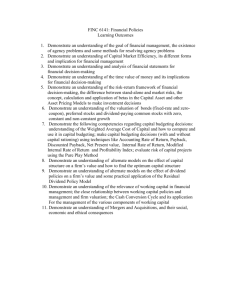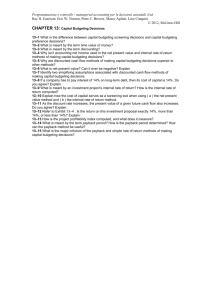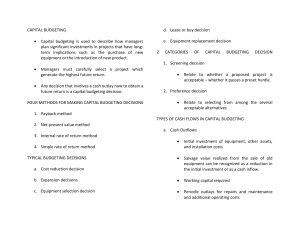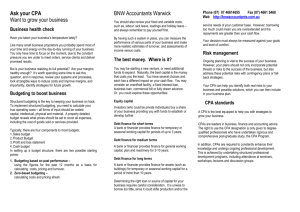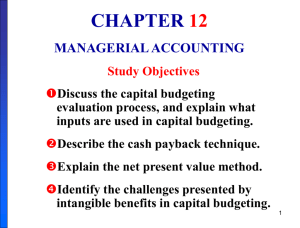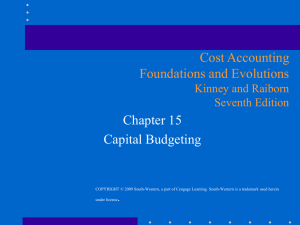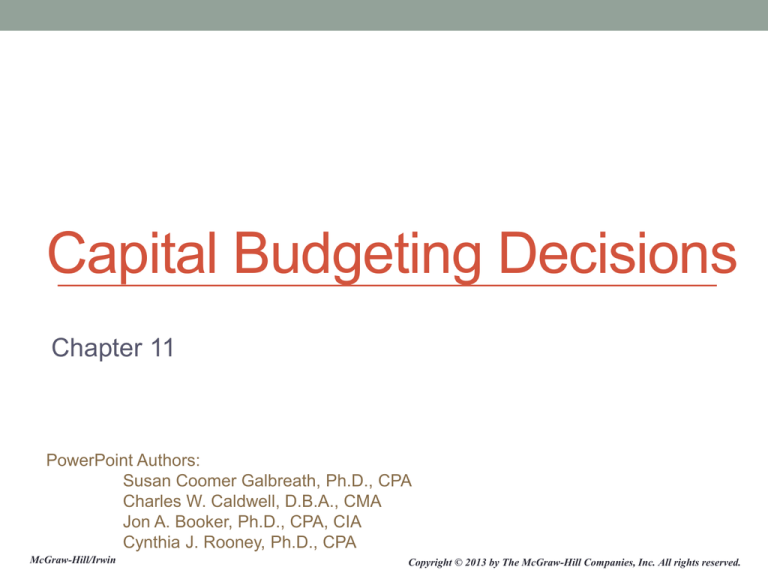
Capital Budgeting Decisions
Chapter 11
PowerPoint Authors:
Susan Coomer Galbreath, Ph.D., CPA
Charles W. Caldwell, D.B.A., CMA
Jon A. Booker, Ph.D., CPA, CIA
Cynthia J. Rooney, Ph.D., CPA
McGraw-Hill/Irwin
Copyright © 2013 by The McGraw-Hill Companies, Inc. All rights reserved.
Typical Capital Budgeting Decisions
Plant expansion
Equipment selection
Lease or buy
Equipment replacement
Cost reduction
11-2
Typical Capital Budgeting Decisions
Capital budgeting tends to fall into two broad
categories.
1. Screening decisions. Does a proposed
project meet some preset standard of
acceptance?
2. Preference decisions. Selecting from
among several competing courses of action.
11-3
Time Value of Money
A dollar today is worth
more than a dollar a
year from now.
Therefore, projects that
promise earlier returns
are preferable to those
that promise later
returns.
11-4
Time Value of Money
The capital
budgeting
techniques that best
recognize the time
value of money are
those that involve
discounted cash
flows.
11-5
The Net Present Value Method
To determine net present value we . . .
• Calculate the present value of cash
inflows,
• Calculate the present value of cash
outflows,
• Subtract the present value of the outflows
from the present value of the inflows.
11-6
The Net Present Value Method
If the Net Present
Value is . . .
Then the Project is . . .
Positive . . .
Acceptable because it promises
a return greater than the
required rate of return.
Zero . . .
Acceptable because it promises
a return equal to the required
rate of return.
Negative . . .
Not acceptable because it
promises a return less than the
required rate of return.
11-7
The Net Present Value Method
Net present value analysis
emphasizes cash flows and not
accounting net income.
The reason is that
accounting net income is
based on accruals that
ignore the timing of cash
flows into and out of an
organization.
11-8
Choosing a Discount Rate
• The firm’s cost of capital is usually
regarded as the minimum required rate of
return.
• The cost of capital is the average rate of
return the company must pay to its longterm creditors and stockholders for the use
of their funds.
• The cost of capital is usually regarded as
the minimum required rate of return. When
the cost of capital is used as the discount
rate, it serves as a screening device in net
present value analysis.
11-9
Preference Decision – The Ranking of Investment
Projects
Screening Decisions
Preference Decisions
Pertain to whether or
not some proposed
investment is
acceptable; these
decisions come first.
Attempt to rank
acceptable
alternatives from the
most to least
appealing.
11-10
Net Present Value Method
The net present value of one project cannot
be directly compared to the net present
value of another project unless the
investments are equal.
11-11
The Payback Method
The payback period is the length of time that it
takes for a project to recover its initial cost out
of the cash receipts that it generates.
When the annual net cash inflow is the same
each year, this formula can be used to compute
the payback period:
Payback period =
Investment required
Annual net cash inflow
11-12
Simple Rate of Return Method
Does not focus on cash flows – rather, it focuses on
accounting net operating income.
The following formula is used to calculate the simple
rate of return:
Simple rate Annual incremental net operating income
=
of return
Initial investment*
*Should be reduced by any salvage from the sale of the old equipment
11-13
Postaudit of Investment Projects
A postaudit is a follow-up after the project
has been completed to see whether or not
expected results were actually realized.
11-14
End of Chapter 11
11-15


